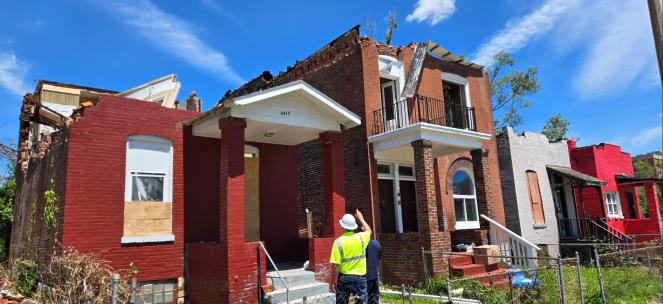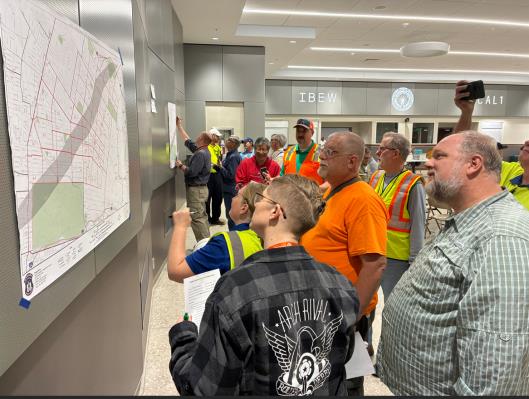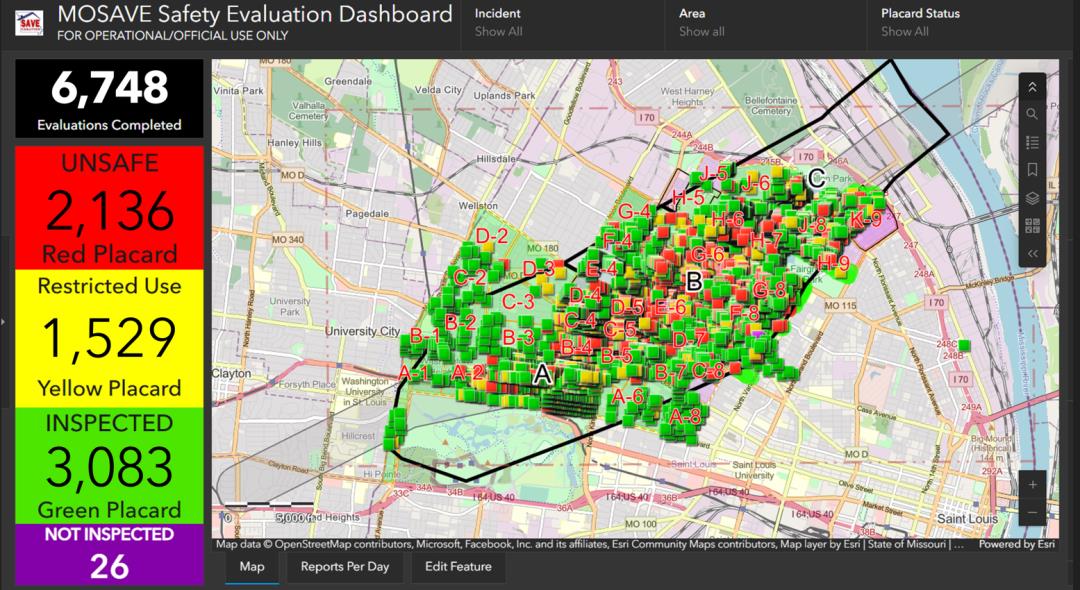SAVE Coalition’s Largest-Ever Deployment Helps Tornado Response in St. Louis
The EF-3 tornado that hit St. Louis May 16 damaged thousands of homes and other structures. In the aftermath, the City of St. Louis needed to evaluate damaged buildings to determine which were safe to occupy, but the job was too big for city building inspectors. So they called the SAVE Coalition for assistance.
The SAVE (Structural Assessment and Visual Evaluation) Coalition is a group of more than 1,000 volunteer architects, engineers and building officials that are trained to quickly evaluate damaged buildings after a disaster. SAVE inspectors conduct a rapid evaluation of each structure’s exterior, then place a red (unsafe), yellow (restricted use) or green (safe) placard on the building. The coalition is trained and deployed under the authority of SEMA.
The city requested assistance May 17, and SAVE got to work over the next several days organizing logistics, contacting volunteers and making travel arrangements. Many of the SAVE volunteers came from the St. Louis area, but all areas of the state were represented in this large deployment.
 SAVE volunteers and city staff in two-person teams spread out over the damaged area for eight days, evaluating more than 6,700 buildings.
SAVE volunteers and city staff in two-person teams spread out over the damaged area for eight days, evaluating more than 6,700 buildings.
“We got a great response to our request for assistance on very short notice,” said Dennis Kidwell, who coordinated SAVE’s outreach for inspectors. “We asked for 60 inspectors, and got more than enough volunteers very quickly. I’m always impressed that our folks are willing to jump into the fray with no hesitation.”
After a walk-through of the damaged areas with city officials and SAVE leadership May 20, SAVE began its four-day deployment May 21. Working with city inspectors, SAVE spread out across the damaged area in more than 25 two-person teams, covering an average of 40 buildings per day per team.
Each deployment day started with an overview of the areas to be covered, and a refresher on what to look for. “All our volunteers have been trained, but it may have been a while ago, and some of them have never actually done this in the field,” said SAVE Training Coordinator Ted Pruess. “A quick reminder is important, and helps us make sure the evaluations are consistent.”
In addition to putting placards on the buildings, SAVE teams used a phone app to input details on each building. The app notes the location of each building, photos of the damage, as well as the placard color. As these details are recorded, a map tied to the app updates live, and the map can be displayed at a command center or any other location so officials can track the deployment’s progress in real time.
At the end of the four-day deployment, more than 3,700 structures were evaluated. The map link, which includes all data on all structures, was turned over to the city for its use in recovery efforts.
SAVE volunteers returned to their lives, and the coalition’s response seemed to be at an end. But that was about to change.
 Each morning SAVE volunteers received a briefing, including checking maps to find their assignments for the day.
Each morning SAVE volunteers received a briefing, including checking maps to find their assignments for the day.
As the city continued its recovery efforts, building officials realized that there were thousands of additional structures that had been damaged by the tornado, and more help was needed. So a second request was made of SAVE, to deploy again for more structural evaluations.
“SAVE has never been asked to deploy twice in a row for the same disaster; that’s asking a lot of our volunteers,” said Ben Ross, one of SAVE’s on-site leaders. “But the city really needed the help, so we responded. Our volunteers really stepped up, and were able to cover lots of additional buildings.”
The second four-day deployment started June 6. In addition to the technology already in use, this deployment made use of aerial photography of the damaged areas, allowing inspectors to see flat roofs on some of the larger structures.
All told, the SAVE Coalition and city staff evaluated 6,748 buildings over eight days – 2,136 red tags, 1,529 yellow tags, and 3,083 green tags. It required the work of 109 volunteers, many of them working multiple days, along with city inspectors. The volunteers put in more than 2,000 hours of labor. In both deployment days and volunteers, it was the largest deployment in SAVE’s history.
 SAVE used a phone app that recorded placard color and building details. The app populated a map that updated live, so officials could monitor evaluation progress in real time.
SAVE used a phone app that recorded placard color and building details. The app populated a map that updated live, so officials could monitor evaluation progress in real time.
“I found the SAVE coalition to be a highly organized group of dedicated professionals,” said City of St. Louis Building Commissioner Ed Ware. “Without their assistance, St. Louis would be struggling with the task of trying to catalog the tremendous damage that occurred on May 16th. To put it simply, they are an outstanding group of men and women!”
